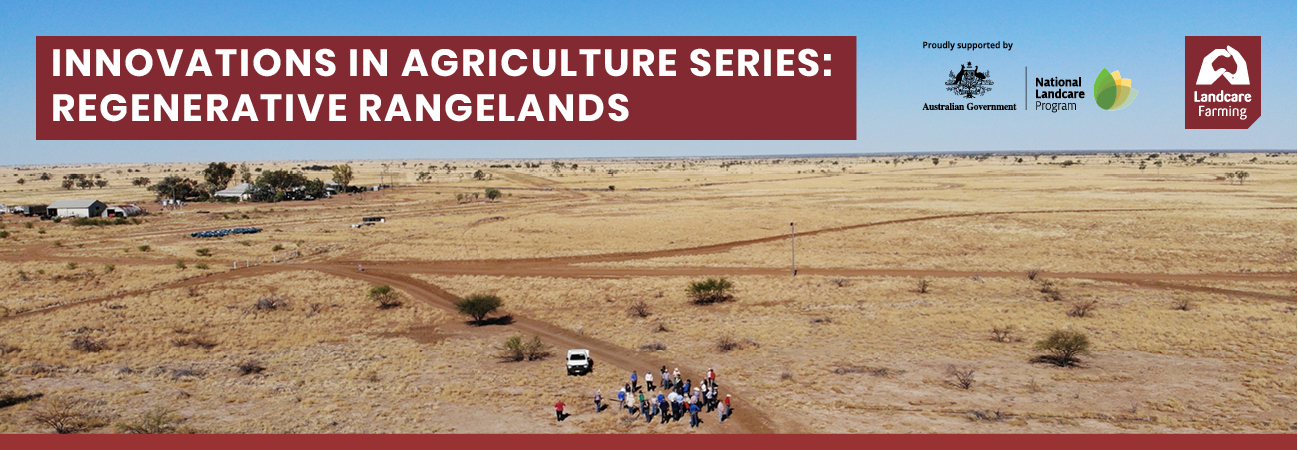
Innovative rehydration techniques combat drought and erosion in the rangelands
Queensland producers have found effective methods of retaining soil moisture from interventions costing as little as $10 a hectare, resulting in productivity and biodiversity gains.
Troy and Amy Kuhn have been grazing sheep, cattle and goats on ‘Nickavilla’, a 16,400ha Quilpie property they took over seven years ago. Due to the impacts of ongoing drought, their property is home to a significant erosion feature Troy describes as “chewing the valley away”, and he estimates they have lost “almost 15 feet” of topsoil due to runoff.
Quilpie has an average yearly rainfall of just under 350mm, and to counteract erosion and conserve soil moisture, Troy and Amy have created ‘timber walls’ which are banks of dead and dry timber, and also constructed contoured ‘spreader banks’ of soil to disperse water more evenly across bare soils, preventing it from rushing into the erosion features and taking topsoil with it. As a result, the water now moves more slowly across the property, allowing increased soil moisture infiltration, promoting ground cover while also mitigating erosion.
Anthony Glasson, who runs Picarilli Station, a 109,000ha Merino sheep and composite breeding enterprise in Thargomindah, is using a similar technique to rehydrate his property.
Like the Kuhns, Anthony’s property has been severely affected by periods of drought which left large volumes of Mulga (Acacia aneura) dead. With the aim of slowing water flows and rehydrating the Mulga flats, Anthony used the wood from the dead Mulga to construct a 1km mixed timber wall and dirt spreader bank. Water previously disappeared from the flats six to twelve hours after a flood event; now it takes more than 48 hours for the water to move through the landscape.
“I have seen water still trickling through these timber walls up to five days after a rain event,” said Anthony, who has also seen other benefits including improved groundcover across the wider areas of his property.
Local resource management consultant Glenn Landsberg from Southern Queensland Landscapes said rehydration techniques such as spreader banks and timber walls are helping producers take preventative measures against the impacts of drought, reduce soil erosion and improve production across their whole property through the increased availability of groundcover.
“If we focus on those highly productive areas, what we’re finding is that it starts a chain reaction. It takes the pressure off the surrounding landscapes and that restoration flows on throughout the property,” said Glenn. “We’ve had to learn ways to do things incredibly cheaply and look for those big bang for buck situations where you can improve a huge area for very little cost.”
Glenn said while a large percentage of Queensland’s rangelands landscape can appear arid and barren, with the right land management techniques that support conserving water, some areas can be transformed into wetlands and floodplains. This is something he hopes will be recognised and quantified in future through the development of environmental markets.
Restoration of already established wetlands and water features has also been the focus of Louise and Dan Hoch who run “The Lake” and “Maybe”, a combined 23,600ha mixed enterprise north of Quilpie, with tourism, sheep and cattle.
The Hoch’s used a grader to create approximately 20km of spreader banks across the clay pans on their property in 2020. The spreader banks have enabled the Hoch’s to make the most of the higher-than-average rainfall in the past few years to support the regrowth of vegetation in these areas. Just two weeks after construction of the banks, the farm received 500mm of rain (an extreme event in this region) and groundcover re-established within a month.
Louise said she estimates the areas with spreader banks produce up to four times the volume of feed produced before the banks were introduced. Reducing the erosion which can cause silt to build up in the lake on their property means they’ve also encouraged native wildlife back into the area.
“It’s helped with the native animals because we’ve got so much more groundcover,” Louise said. “There’s a lot of little wetlands and [the native birds] stay there for so much longer now because the water’s all slowed down.”
The work on Louise’s property cost approximately $10 per hectare (including dry-hire of the grader), and demonstrates significant improvements to the landscape and productivity for minimal financial inputs.
This case study was produced as part of the Landcare Farming Innovations in Agriculture Series. Supported by the Australian Government’s National Landcare Program, the Landcare Farming Innovations in Agriculture Series is managed in partnership by Landcare Australia and the National Landcare Network.



